- Administrator
- Albums and Singles
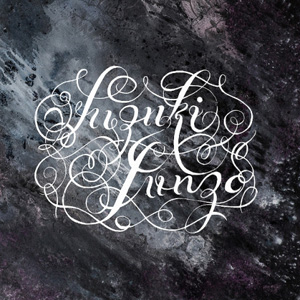 Suzuki Junzo has spent much of his career shifting between gentle, almost jazz influenced guitar playing and full on unhinged distortion, both as a solo artist and with projects such as Astral Traveling Unity. That hopping between extremities remains solidly in place on Portrait of Madeleine Elster, which is almost evenly split between gentle, jazz influenced playing and maximum, room clearing distortion. Its best moments, however, are when the two worlds overlap with one another and create an entirely different beast.
Suzuki Junzo has spent much of his career shifting between gentle, almost jazz influenced guitar playing and full on unhinged distortion, both as a solo artist and with projects such as Astral Traveling Unity. That hopping between extremities remains solidly in place on Portrait of Madeleine Elster, which is almost evenly split between gentle, jazz influenced playing and maximum, room clearing distortion. Its best moments, however, are when the two worlds overlap with one another and create an entirely different beast.
It is only on the title song that Junzo's playing stays muted and calm throughout.Gently strummed electric guitar is the only major element, occasionally drifting into jazz improvisation at times and then pulling to subtle strums.On "La Notte," Junzo's guitar becomes more distorted and raw in its sound, but staying under his control.The whole song ends up enshrouded by a lo-fi rehearsal room ambience, and guest Ikuro Takahashi's (LSD March) drumming has an erratic, extremely unique quality to both the sound and the rhythms.
Takahashi also appears on "When the Grey Skies Turn Blood Red," but his playing is obscured somewhat by Junzo's decidedly unsubtle, balls out guitar noise.Squealing, shrieking, buzzing feedback is the name of the game, and it does not relent for the nearly 16 minute piece.The drums have the same odd tuning to them, and when they can be heard the hybrid of free jazz improvisation and grindcore style blastbeats supplement the guitar squall wonderfully.
The closing composition, "Dance of the Inhabitants of the Invisible Tower in the Ring of Holy Mountain," makes for an ideal centerpiece of the album, and also perfectly encapsulates Junzo's sound and style.Beginning with a slightly ragged strummed guitar motif, layers are piled atop it at the perfect pace.Distorted harmonica, what sounds to be bowed guitar and possibly electronics all slowly enter the mix, resulting in an intense, dramatic crescendo that began with the simplicity of a single electric guitar strum.
Even though Portrait of Madeleine Elster is heavily built upon these opposing approaches of gentle and harsh, it is the overlap that leads it shine most.During its noisiest passages there remains, sometimes deeply buried, a sense of true beauty.At the same time, the gentle strums and deliberate notes have a distorted, raw coating to them that keeps the playing from becoming too placid, accenting it with just the right amount of grime.It is this tension between the two that give this album the strength and power it has, and it is a sound like no other.
samples:
- When They Grey Skies Turn Blood Red
- La Notte
- Dance of the Inhabitants of the Invisible Tower in the Ring of Holy Mountain
 
Read More
- Administrator
- Albums and Singles

It has been a very long time since a formal Diane Cluck album has surfaced, as even the collages/odds-and-ends collection Monarcana dates from nearly a decade ago.  However, she has been far from idle during her "hiatus," touring regularly and releasing an irregular trickle of excellent new work through both a tour CDr and her ongoing (and ambitiously mis-named) "Song-of-the-Week" project.  Of course, the downside to that piecemeal approach is that the bulk of these new pieces (and their arrangements) will already be quite familiar to devoted fans, but those who have not been closely monitoring Diane's recent activity have a couple of her finest songs ever awaiting them.
Diane's work has undergone quite a significant evolution since her last major statement (2005's Countless Times), which is certainly to be expected–people can change a lot in 9 years and Diane is no exception.  For the most part, however, the transformation from Countless Times-era Cluck to Boneset-era Cluck is entirely a positive one, though I admittedly miss her early intensity, vocal layering, and playful sense of experimentation.  In their place, however, is a much stronger emphasis on songcraft and consistency: there are no spontaneous one-take performances or sketches to be found on this latest effort, just 8 complete, well-crafted songs that have been gradually distilled into their current states through months and months of touring.  Diane has always been an amazing songwriter and performer, but now it seems like she is quite a bit more comfortable with those roles.
While some of Cluck's earlier fire, ragged off-the-cuff charm, and chills-down-my-spine rawness may be gone, the more organic and earthy aesthetic embodied by Boneset is not entirely a softening of Cluck's edges, as her lyrics are just as personal, poetic, idiosyncratic, articulate, wise, tender, and moving as ever.  The most disquieting of the batch is one of the earlier pieces, "Content to Reform," where she addresses the EP's primary theme of cyclical death and rebirth in particularly unflinching sharp-focus ("I die and I die, sloughing off cells....everything spends out its day and then its content will reform until it breaks again.").  As bleak as that sounds (it is bleak), it ultimately comes across as a perversely joyous and eerily beautiful piece, owing largely to its moaning cello accompaniment and lilting vocal melody.
The album's other centerpiece is a relatively new song, "Heartloose" (the pieces are arranged in rough chronological order).  Again, Cluck is joined by cellist Isabel Castellvi, but "Heartloose" is considerably more propulsive and Romantic in theme than "Content."  To my ears, it easily stands among Cluck's best work, offering up great melody and lyrics that are absolutely heart-melting in their guilelessness, particularly the final verse ("And I have so much for you!  Do you know how I get shy to show you?").  Yet another fine piece is Boneset's darkly exotic closer, "Sara," which features an unusual stuttering melody; references to Hindu and Mesopotamian goddesses of destruction and the underworld, and lyrics like "her dirt rain dark down, my falling skin stripped so lonely."
If Boneset has a flaw, it is that there is too little of it.  Aside from containing only two truly new songs (the piano-based "Why Feel Alone" and the largely a capella "Not Afraid to Be Kind"), half of the songs hover around the 2-minute mark.  That latter trait inadvertently amuses me quite a bit, as it almost seems like Diane was hell-bent on perfectly adhering to Wire's famous 1977 Rules of Negative Self-Definition (no decoration; no chorusing out; keep to the point; when the words run out, it stops; etc.).  Though I am sure that Cluck crafted these pieces completely independently of advice from any aging post-punk luminaries, that aesthetic works just as well for her as it did for Pink Flag–Boneset is direct, distinctive, and powerful despite ostensibly treading genre territory that has been well-covered.  While it does not necessarily eclipse any of Diane's past triumphs (such as Oh Vanille), Boneset is most certainly still on the same level as them.  More importantly, it is a hugely welcome return for a singular artist that has been far too quiet for far too long.
Samples:
 
Read More
- Administrator
- Albums and Singles
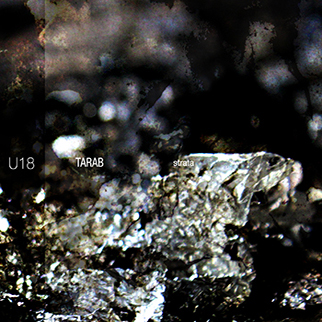 Eamon Sprod records music in the field, but don't mistake the product of his labor for a field recording. In some hands microphones and tapes are used to capture the buzz of insects or the sound of rain pelting the land—whatever the subject might be—with the intent of faithfully reproducing those sounds later in a living room or in a pair of headphones. Replication is the documentarian's craft. Sprod's is magnification. He singles out particular noises, brushes them off and, like a geologist or an archaeologist, excavates them from the sediment of ordinary commotion. His efforts yield an enlarged world of microscopic rhythms and porous surfaces, small remnants that point to the unbroken environments from which they were culled. But Sprod re-purposes those extractions as musical vehicles too, for both re-hearing and re-imagining the world.
Eamon Sprod records music in the field, but don't mistake the product of his labor for a field recording. In some hands microphones and tapes are used to capture the buzz of insects or the sound of rain pelting the land—whatever the subject might be—with the intent of faithfully reproducing those sounds later in a living room or in a pair of headphones. Replication is the documentarian's craft. Sprod's is magnification. He singles out particular noises, brushes them off and, like a geologist or an archaeologist, excavates them from the sediment of ordinary commotion. His efforts yield an enlarged world of microscopic rhythms and porous surfaces, small remnants that point to the unbroken environments from which they were culled. But Sprod re-purposes those extractions as musical vehicles too, for both re-hearing and re-imagining the world.
Strata is a telling title. Maybe the perfect title for this album, because, in order to get what he wants, Sprod has to dig into the dirt. He trains his microphones on the gritty crunch of busted concrete and loose gravel, buries them in the ground to pick up the vibrations of subway trains, and lets them loose over a wide surface where dogs bark and the hum of cars, planes, and other machines mingle chaotically. Most public spaces are filled with sounds like these, but they pass by unnoticed for a variety of reasons: visual distractions pull our attention away from them or other sounds roar rudely into our ears masking the quieter noises that smolder in the dark. Some sounds require special equipment to hear and other times there is simply too much happening to catch it all at once. Whatever the case, our senses fail to report the entire scene. Sprod's method of recording and composing brings those silenced sounds back to consciousness, with a twist.
They arrive incrementally and without context, fragments of the vacant lots Sprod recorded near Macaulay Station and Moonee Ponds Creek in North Melbourne, Australia. From the piston-pumping whoosh of car engines on a raised highway to the sibilant hiss of old pipes; from birds chirping to creaking boards, to tape distortion and the harmonic ring of metal on metal, each scene appears out of the blue, placed shoulder to shoulder with its neighbors by means of sudden cuts, quick fades, and clever mixing. Rhythm and pace take precedent over the sounds themselves as Sprod turns his attention from subject to subject. A barrage of noise is followed by an expectant stillness. Dogs bark. Someone kicks a pile of rubble over with their boots and subtle effects creep surreptitiously into their midst. In places the recordings are slowed down or sped up, or are manipulated in some way to add variety.
Strategies like these might have come about as Strata took shape, or they could have been planned out in advance. The blueprint suggested by the title shows through in the way Sprod organizes his sources, but nothing like a composition can be gleaned from that organization. In absence of an outline, it’s very likely that each sequence and edit was decided by the material itself and by Sprod’s ear. There is a peak here and valley there not because of any guiding principle or master plan, but because that sequence seemed appropriate at the time and made for good music. Thoroughness might also have contributed to the album's build, as Strata uses much of its time to focus our attention on overlooked (or under-heard) phenomena. Events move through the frame only after they've been treated meticulously and no sooner. What counts as meticulous depends entirely on interest, and since this is Sprod's record, it's his interests that matters.
By intuition or by whim, Strata takes shape. And from that shape both music a deepened field materialize. All the nooks and crannies usually obscured by the bigger picture come to the fore, as if blown up under a microscope, and they bring two of North Melbourne's deserted locales back to life with them. Not just by virtue of their sounds; the music reaches further than that. It travels through the audible frequencies and into the brain where it teases the imagination to work. An awareness of how these places must have felt emerges. It's a subjective report, filtered through Eamon Sprod's subjective lense, but it captures the lay of the land in a way that few documentary recordings could.
samples:
 
Read More
- Administrator
- Albums and Singles
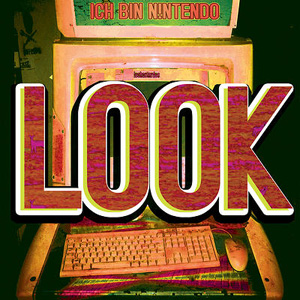 About a year since the Norwegian trio released their first album with legendary saxophonist Mats Gustafsson, Ich Bin N!ntendo present Look. Without any guest artists (but once again recorded and mixed by Lasse Marhaug), the material does not differ significantly from its predecessor, and it still makes for a sprawling discordant mess in the most enjoyable way. Like a free jazz metal band playing punk covers out in a garage, there is a visceral, but fun sensibility to be had within all of this chaos.
About a year since the Norwegian trio released their first album with legendary saxophonist Mats Gustafsson, Ich Bin N!ntendo present Look. Without any guest artists (but once again recorded and mixed by Lasse Marhaug), the material does not differ significantly from its predecessor, and it still makes for a sprawling discordant mess in the most enjoyable way. Like a free jazz metal band playing punk covers out in a garage, there is a visceral, but fun sensibility to be had within all of this chaos.
Without Gustafsson on this album, IBN is Christian Skår Winther on guitar, Magnus Skavhaug Nergaard on bass, and Joakim Heibø Johansen on drums.The trio's instrumentation may be more in league with a punk band, and there is definitely that element to them, but the penchant for building up complex rhythmic structures to just pull them apart into a massive squall is more free jazz in its concept."Cream Corn Wand" leads off with an abused guitar that almost sounds like a brass instrument being assaulted for two straight minutes before the rhythm section jumps in.When it does, it manages to convey some sort of overdriven noise jazz funk from deep within the noise.
The erratic drums and bent strings of "Live and Let Live" might not exert as many changes as some of the other compositions on here, but in its short duration it covers quite a bit with a similar funkiness to it.The random noises opening "Star City" paired with some sort of horrendous vomit like guttural noises bears a passing resemblance to Yamatanka Eye's vocals both with the Boredoms and Naked City, but the rest of the song more closely resembles the latter.Oscillating between jazzy improvisation and thrashing metal, the trio lock together tightly to just fall apart again, with a distinctly jovial and loose sound.
One thing different on Look is the use of vocals, or at least some approximation of them.Opener "Endless Bovis" features either Winther or Johansen screaming from far in the background, and with the messy rhythmic structure it sounds like a garage band skronking out even more so.When the moments of restraint appear, there is a sense of tension that builds and builds to a satisfying free form freakout.The screaming is also a prominent facet of closer "Let's Toast!," and with the rapid, pummeling drums and overdriven guitar and bass roaring, everything melts into a wall of fuzzed out noise
Probably the strongest characteristic of Look is simply that sense of looseness and fun that pervades the entire album.Rather than being stuffy and overly formal in their approach, the trio bathe in the noise and chaos that they make, and it is that sense of garage exuberance that works so well.Punk is a word that has been so overwrought as to lose its meaning, but the spirit of it is alive and well with Ich Bin N!ntendo, even if it has been entirely recontextualized.
samples:
 
Read More
- Administrator
- Albums and Singles
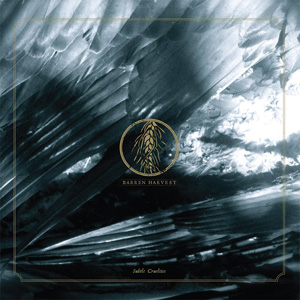 As a genre or style, neofolk has always been more miss than hit for me. I am a huge fan of the early through mid period Death in June, Sol Invictus, and a few others, but too often it comes across like low rent Leonard Cohen with a questionable sense of nationalism. The debut from Barren Harvest, featuring members of Worm Ouroboros and Atriarch, does not fall into this trap by any means. With balanced implementation male and female vocals and a tasteful use of keyboards with the acoustic instruments, the album is somewhere between Nada! era DIJ and the stronger moments of mid-period Swans, while still retaining its own identity.
As a genre or style, neofolk has always been more miss than hit for me. I am a huge fan of the early through mid period Death in June, Sol Invictus, and a few others, but too often it comes across like low rent Leonard Cohen with a questionable sense of nationalism. The debut from Barren Harvest, featuring members of Worm Ouroboros and Atriarch, does not fall into this trap by any means. With balanced implementation male and female vocals and a tasteful use of keyboards with the acoustic instruments, the album is somewhere between Nada! era DIJ and the stronger moments of mid-period Swans, while still retaining its own identity.
The Swans reference is most apparent when it comes to the vocals, with Lenny Smith (Atriarch) and Jessica Way (Worm Ouroboros) bearing a passing resemblance to Gira and Jarboe's work at the White Light From the Mouth of Infinity/Love of Life era of the band.While I realize this is a contentious time in that band's history, the high points on those albums were no less powerful than their other work.Like those records, both Smith and Way have that macabre, morbid quality to their voices that fits the music perfectly.
The bulk of the songs on Subtle Cruelties mesh low end synth strings with passages of gentle acoustic guitar, such as on the opener "The Bleeding."On "Claw and Feather," the sound slowly builds from these two components into a richer, more complicated mix that hits just the right level of dramatic without going over the edge.On songs like "Heavens Age," the duo emphasize guitar, with Smith's vocals channeling Nick Cave and Peter Murphy equally to give a wonderfully morose early death rock feel before Way’s somber voice kicks in to give a different feel.
"Memoriam II" is a case in which the electronic elements become the focus, with the electronics conjuring wonderfully bleak moods, and with the dramatic swells and vocals. It sounds as if it could have been recorded in 1981 at the height of post-punk."Memoriam VI" is also built more on the electronic atmosphere, with the lighter synths offsetting the darker, more desolate singing.
The greatest moments are where the two are nicely balanced, such as on "Coil Uncoil" where gentle acoustic guitar is first paired with Smith’s graven vocals, then lightened up by Way’s while everything retains just the right amount of rough hewn sound and dissonance.The album’s centerpiece is the long "Reveal," in which the duo initially emphasizes atmospheric electronics and echoing autoharp, mixed with rich, multitracked vocals from both.Slowly piano and electronics are introduced to the mix, building in depth and complexity to become the most complex and powerful piece here.
These dualities are what define Subtle Cruelties:male versus female vocals, organic guitar and synthetic keyboards, and a clashing sense of light and dark.The sound of the record conveys this as well, being both vintage in feel but modern in its approach.Even in the titling of the project and record captures the dichotomy of nature: cruel but indifferent.The album's vinyl release also deserves special mention, because in addition to the more conventional black and gold versions, a limited clear vinyl pressing is also available, with actual autumnal leaves encased in the record itself, something I have never seen done before personally.It makes for a unique presentation for an extremely singular, albeit bleak piece of music that has already made my short list for top records of 2014.
samples:
 
Read More
- Administrator
- Albums and Singles
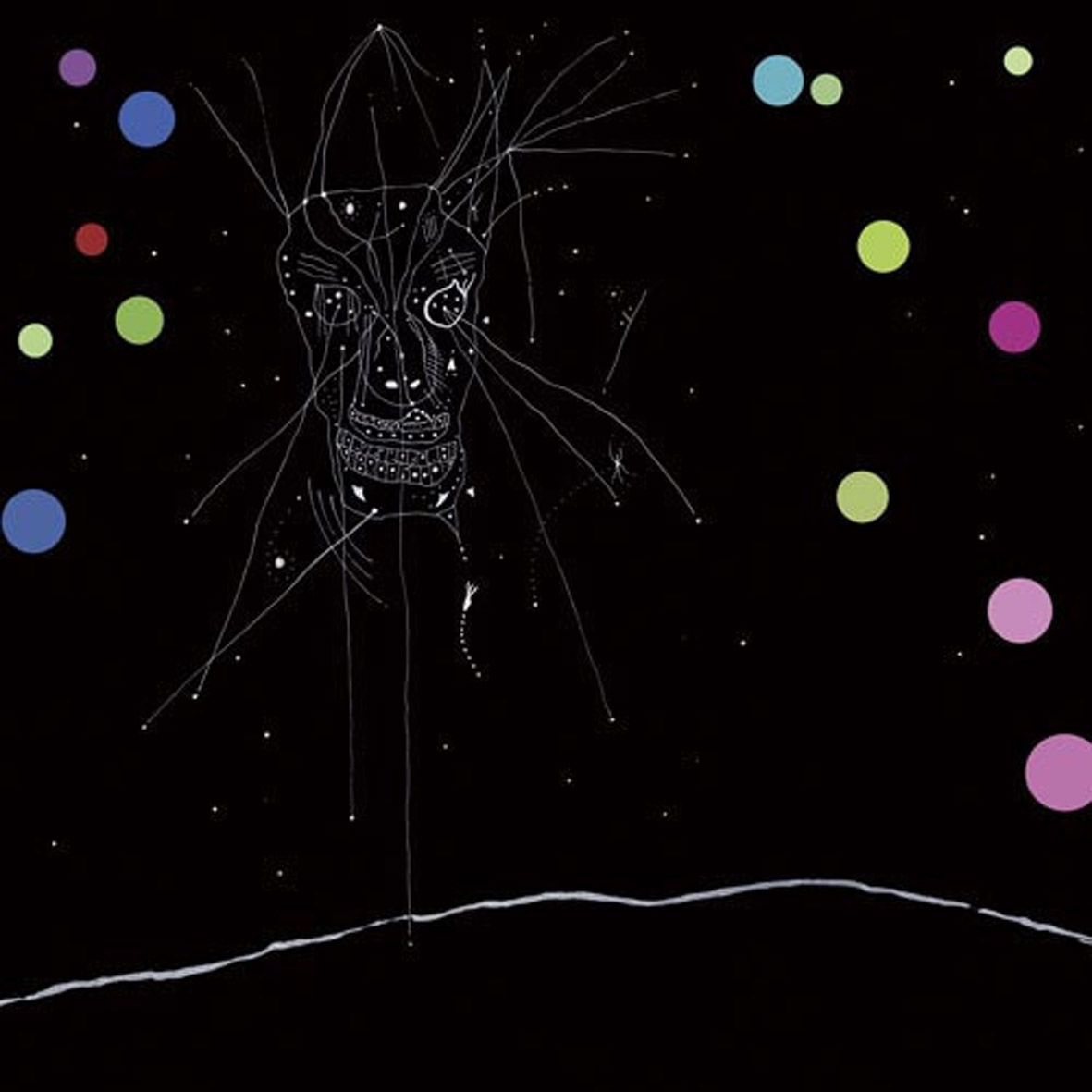 One of the many things that still keeps me excited about Current 93 more than 30 years into their career is that each new incarnation has the potential to be a stunning or reinvigorating reinvention of David Tibet's vision.  This latest line-up offers up an especially divergent and unexpected aesthetic, primarily due to the contributions of Dutch classical pianist Reinier Van Houdt and saxophone titan John Zorn. Although large parts of Field definitely fall a bit short for me, they are happily balanced by some truly wonderful and boldly original moments as well.
One of the many things that still keeps me excited about Current 93 more than 30 years into their career is that each new incarnation has the potential to be a stunning or reinvigorating reinvention of David Tibet's vision.  This latest line-up offers up an especially divergent and unexpected aesthetic, primarily due to the contributions of Dutch classical pianist Reinier Van Houdt and saxophone titan John Zorn. Although large parts of Field definitely fall a bit short for me, they are happily balanced by some truly wonderful and boldly original moments as well.
I am insistent that the opening "The Invisible Church" is a work of pure genius from start to finish, though absolutely no one seems to agree with me thus far.  It begins with some cascading and dissonant minor key chords from Van Houdt before cohering into a simple, melancholy chord progression that inexorably unfolds at a snail's pace, providing the sole constant in a song that seems constantly on the verge of unraveling.
Despite their eclectic backgrounds, every member of the group seems to organically and intuitively understand the "hallucinatory prog rock on the verge of collapse" aesthetic of "Church" perfectly, particularly former Cancer drummer Carl Stokes, whose slow-motion fills always sound like they might just abruptly stop or trail off into nowhere.  Another stand-out is Groundhogs' guitarist Tony McPhee, who contributes a host of very broken-sounding blues licks amidst the increasingly mournful oboe swells and twinkling piano divergences.  Naturally, Tibet himself is in fine form as well, purring apocalyptic poetry like a prophet in the midst of a fever dream.
That wonderful momentum thankfully extends into "Those Flowers Grew," which gradually takes Reinier's minor key arpeggios into increasingly propulsive and wild territory as Zorn's playing evolves from lyrical melodicism into something approaching free-jazz caterwauling amidst harsh snarls of wah-wah guitar.  By the time it reaches the end, it sounds positively unhinged.  Also, the sound itself is spectacular, as all of the various threads weave together with both presence and perfect clarity.  I was also struck by how comparatively loose and organic it felt, as it is rare for Current 93 to sound remotely like an actual band playing together in a room.
Unfortunately, the album then hits a prolonged lull with "Kings and Things."  Of course, the word "lull" is quite relative in the case, as Tibet himself remains magnetic and there is no dearth of great ideas–it is just that the band is never quite firing on all cylinders at once ever again.  Also, Tibet's consistent aesthetic vision of Field is a bit of an inherent liability, as I have never found a piano to be the ideal foil for his vocals and 11 piano-centric songs in a row definitely yields diminishing returns.
That lack of variety was made still more exasperating when I realized that James Blackshaw was relegated to bass and that Cyclobe's Ossian Brown was mostly just around to play hurdy-gurdy on a song or two.  Any respite from the piano at all would have been welcome, but–for better or worse–Rainier Van Houdt seems to be the primary non-David Tibet architect of this release.  Sometimes his playing is absolutely beautiful or virtuousic, particularly his runs into the higher octaves, but he can also seem weirdly leaden or straight-forward as well.  Those latter moments are quite confounding.
One such moment is the late-album nadir,"I Remember the Berlin Boys," a jaunty, lurching piece that would sound uncomfortably like it belongs in a community theater production of a popular musical were it not for David Tibet's ranting about invoking picnic demons into his loins (I certainly hope he succeeds).  Thankfully, the album unexpectedly surges to quite a strong finish after that, as "Spring Sand Desert Larks" offers up an invigorating dose of rapidly rippling, Lubomyr Melnyk-style arpeggios over a muscular waltz beat that almost sounds punk at times.  Also, it helps that Zorn turns up for some strangled saxophone flame-throwing near the end as well.  Field then draws to sublime conclusion with the tender Nick Cave- and Antony Hegarty-sung "I Could Not Shift The Shadows," which resembles a cross between a music box and an old, curiously worded spiritual.
Sadly, three or four fine songs do not quite add up to a great album or even a shadow of the band's Stapleton/Cashmore prime, but Field is at least a strange, bold, and improbable experiment that often works far better than I would have expected it to.  Tibet definitely stepped outside his comfort zone and enlisted a line-up that is bizarre even for a band that previously contained Sasha Grey, as I imagine no one ever expected a guitarist from a '70s British blues band (McPhee) and a controversial religious painter (Norbert Kox) to turn up on the same album.
Also, for lack of better wording, Field employs some very uncool elements in mostly cool ways: it is very hard to play a saxophone melodically in a rock context without sounding like you are celebrating the end of another successful episode of Saturday Night Live, for example.  I definitely appreciated that when it worked.  Consequently, Field's greatest appeal lies in its uniqueness and eccentricity rather than its quality, though I still maintain that at least "The Invisible Church" stands among Tibet's best work.  Also, it should go without saying that even a merely decent Current 93 album is more fascinating than the vast majority of the contemporary music landscape, but I will say it anyway.
 
 
 
Read More
- Administrator
- Albums and Singles
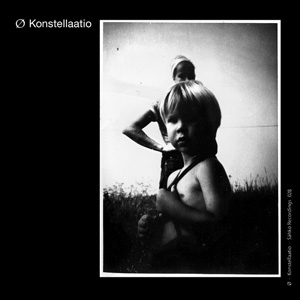 Konstellaatio is yet another release in Mika Vainio's current prolific spate of recordings, and amazingly even here, alone in his solo √ò guise, there seems to be no reduction in quality. Half of this album channels the minimalist techno of Pan Sonic, while the other half hints at moody, sparse ambience that has characterized his other recent works. Like much of his discography, Konstellaatio manages to have an organic warmth amongst its machine generated noises that slowly reveals more of its character.
Konstellaatio is yet another release in Mika Vainio's current prolific spate of recordings, and amazingly even here, alone in his solo √ò guise, there seems to be no reduction in quality. Half of this album channels the minimalist techno of Pan Sonic, while the other half hints at moody, sparse ambience that has characterized his other recent works. Like much of his discography, Konstellaatio manages to have an organic warmth amongst its machine generated noises that slowly reveals more of its character.
The first three songs of this album are the ones that make for the strongest throwback to the Pan Sonic sound."Otava" is carried along on a deep bassline and a synthetic kick drum that approximates a slow tempo house track.This becomes even more apparent with melodic synth pads fleshing it out and even pushing it dangerously close to new age territory without going too far.In a similar vein is "Syvyydessä Kimallus," which matches its sharp inorganic thud and brittle rhythmic pulse bar for bar with gentle passages of spacious ambience.
The first few moments of "Kesäyon Haltijat" are painfully shrill, but it is short lived, replaced by an analog drum thump and white noise puffs to approximate a snare.At the same time, a haunting bell like melody sneaks in and heralds the more placid moments to come on the album.Perhaps the most drastic manifestation of this sound is the ending piece "Takaisin," which is a skeletal song based upon a chintzy drum machine rhythm.Its basic melody gives a lighter, looser feel compared to the bulk of Vainio's work, while his penchant for deep sub bass tones stays in place.
The remainder of this album focuses less on the deep beats and more into pensive synths and electronics.On "Elämän Puu," rhythms are essentially tossed out the window for the sake of pure mood and melody.The bits of random noises that open the piece slowly meld into a melancholy structure, and even with the extreme high and low passages the mood stays somber and hushed."Syvänteessä Pukinjalkaisen" also stays away from rhythms and instead uses mostly soft synth stabs with dramatic low end accents, feeling like a light 1980s synth piece stripped back to its barest essentials.Far different, but still similarly avoiding rhythms is "Talvipäivä, Vanha Motelli," which is mostly a wet, vibrating spring type sound paired with textural static until it closes on digital chimes and sadness.
Even with all of these recent releases, Vainio has upheld his quality control, and also retained distinct identities for each.The ambient moments of Konstellaatio are strong, but I cannot help but favor the beat oriented tracks, with the simple rhythms of techno belying the complexity and nuance of the tones and textures he employs.Like much of his work, it is deceptively simple in its construction, but hides a world of electronic brilliance just below the surface.
samples:
 
Read More
- Administrator
- Albums and Singles
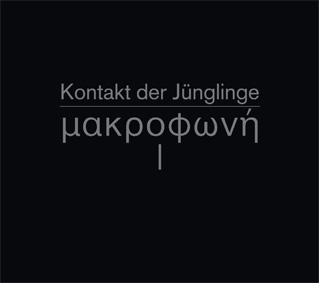 Kontakt der Jünglinge, the cross-generational collaborative project between Thomas Köner and Asmus Tietchens had a burst of activity in the late 1990s and early 2000s, but has since remained rather quiet. This album marks not only their return, but also their first true studio recording. The previous four albums were all live performances, and even the non-live disc Frühruin was actually two solo pieces composed in a similar style. In that regard, Makrophonie 1 accomplishes exactly what it should, capturing the duo’s stark, yet somehow inviting minimal electronics with a greater polish and tightened compositional sensibility that the studio setting brings.
Kontakt der Jünglinge, the cross-generational collaborative project between Thomas Köner and Asmus Tietchens had a burst of activity in the late 1990s and early 2000s, but has since remained rather quiet. This album marks not only their return, but also their first true studio recording. The previous four albums were all live performances, and even the non-live disc Frühruin was actually two solo pieces composed in a similar style. In that regard, Makrophonie 1 accomplishes exactly what it should, capturing the duo’s stark, yet somehow inviting minimal electronics with a greater polish and tightened compositional sensibility that the studio setting brings.
On the surface, the album seems as if it could be a complete 180 from what preceded it.Gone is the stark black mathematical text on white backgrounds, which more closely resembled an academic paper than an album cover.Instead it is replaced with a whole lot of black with dark gray text, and even the disc itself is black on both the playable and label surfaces.Thankfully though, the music contained within is very much consistent with the duo’s previous work.
Presented in the same fashion as the recordings from last decade, Makrophonie 1 is a single, nearly 40 minute piece of interlocking passages that bear the mark of both artists’ signature sound, but presented with the sound of a true collaboration.The extremely low frequency opening punctuated with short, noisier bursts somehow manages to be a calm introduction, even with its dissonant moments.Plinking, unrecognizable sounds and what sounds like the slightest hint of a melodic passage slip through in through these moments.
This dichotomy between the understated melodic and tasteful dissonance is a recurring theme throughout this piece, which is not all that surprising given that both Tietchens’ and Köner’s solo works are often based on the same sort of concept.Ghostly sweeps of dark, haunting tones mix with crackling, phased static early on, with both trading off to create a dramatic, swirling build of intense music that sounds richer and more fully realized than what was captured on their live collaborations.
At times there almost develops a sense of rhythm, admittedly loose and non-traditional, which harkens back to both artists’ earlier works.While it does not clearly resemble Tietchens’ early synth pop like instrumental miniatures or the deconstructed dance music of Köner’s other project Porter Ricks, shrill beeps and sub bass throbs do lock into a sort of rhythmic collage of complex noise and clinical tone.The same sub-aquatic low end processing of Porter Ricks also appears throughout, as does Tietchens’ love of intricate, almost tactile noise.
Kontakt der Jünglinge might not make the most accessible music, but for all its abstraction, Makrophonie 1 is far less abrasive and off-putting than artists working with similar sounds.Perhaps it is due to both Köner and Tietchens having worked in more traditional styles before, because there is a sense of musicality here that is buried and hidden, but undeniable in its presence.It is for this reason that this album stands out as something pleasurable to listen to, rather than a clever experiment or endurance test.
samples:
 
Read More
- Administrator
- Albums and Singles
 This fourth full-length by the revered (yet somewhat chameleonic) David Lettelier takes his techno in a simpler and more spacious direction than its 2011 predecessor (OR) with varying degrees of success.  While I have seen this effort compared to early Autechre or referred to as "IDM" or "retro" several times, it does not feel much like a deliberate nostalgia trip at all to me.  Such reference points are not exactly off-base, but Solens Arc often seems much more like Lettelier has merely discovered that a throbbing, non-intrusive rhythmic backdrop is the perfect framework for presenting his more experimental leanings.
This fourth full-length by the revered (yet somewhat chameleonic) David Lettelier takes his techno in a simpler and more spacious direction than its 2011 predecessor (OR) with varying degrees of success.  While I have seen this effort compared to early Autechre or referred to as "IDM" or "retro" several times, it does not feel much like a deliberate nostalgia trip at all to me.  Such reference points are not exactly off-base, but Solens Arc often seems much more like Lettelier has merely discovered that a throbbing, non-intrusive rhythmic backdrop is the perfect framework for presenting his more experimental leanings.
Tellingly, Lettelier has both a career in architecture and some time in noise-rock bands in his resume: two threads that manifest themselves quite clearly on Solens Arc.  David seems to have made a conscious effort to build these songs from only the most simple and necessary components and to purge them of all possible clutter.  In that regard, this album is a complete success, as his palette of thumping bass drum, synthesizer, and gnarled, heavily processed guitar throws everything into sharp relief and makes every single sound count.  That approach works beautifully when a piece is built upon a strong motif, like the wobbly, ravaged-sounding swells of "Transitional Ballistics" or the sizzling, panning ambient thrum of "Apogee."  It is less successful, however, when the composition falls a bit short in some capacity.
Usually those shortcomings come in the form of dated-sounding synth textures, which was a bit unexpected for me, as Solens Arc also has quite a few four-on-the-floor house beats, which is something I usually loathe.  David does an admirable job of keeping them to a low simmer though, rather than using them to bludgeon me with forced excitement.  David's synthesizer arpeggio hooks are a legitimate problem though, as they definitely take otherwise great pieces like "L'Envol" and "Amber Decay" down a peg with their artificial, stuck-in-the-late-'90s burbling.  That is very exasperating, as the alternately snarling and distantly hollow guitar swells of "Decay" are otherwise prime grist for a killer song.  Also, the synths feel weirdly out of character with the rest of the album's aesthetic, as Letellier is otherwise extremely adept at avoiding anything that seems heavy-handed or too on-the-nose.
I suspect people with deeper nostalgia for the '90s dance underground or less of a subjective hostility towards synthesizer arpeggios will get a lot more out of this album than I did, but I was definitely very impressed by David's clarity and skill nonetheless.  There is a lot of legitimately great material here (I also liked the lurching, hissing opener "Serendipity March") and it is generally executed in a distinctive way.  Unfortunately, the sprinkling of dated techno tropes and textures waters down what should have been a uniformly excellent album.  As it stands, "Transitional Ballistics" is the only unqualified success on Arc to my ears, but its assemblage of inspired near-misses is still significantly more appealing and expertly realized than the bulk of Kangding Ray's peers.  At its best, Arc more closely resembles experimental music with a strong pulse than a mere well-crafted trip back to the more discriminating dancefloors of decades past–I just wish it was at its best more often.
Samples:
 
Read More
- Administrator
- Albums and Singles
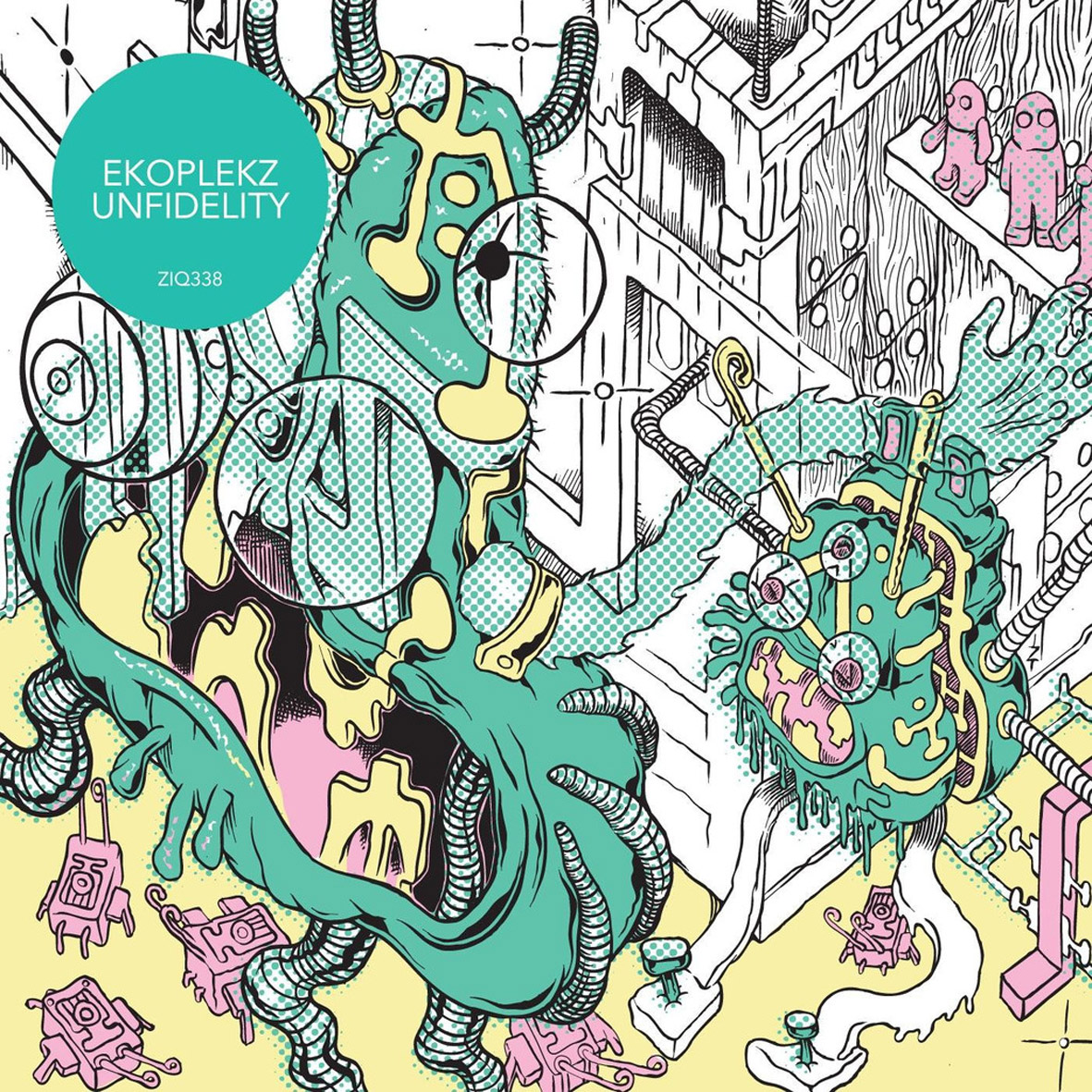 Despite constantly encountering his many guises in The Wire and elsewhere, I never actually got around to investigating the extremely prolific Nick Edwards until now.  As usual, however, my timing is almost supernaturally perfect, as his first effort for Planet Mu is being rather unanimously hailed as his creative zenith.  I cannot vouch for that myself, but Unfidelity is certainly a very cool album, sounding like an especially hallucinatory strand of dub techno mingled with a deep appreciation for kitsch and absurdist fun.
Despite constantly encountering his many guises in The Wire and elsewhere, I never actually got around to investigating the extremely prolific Nick Edwards until now.  As usual, however, my timing is almost supernaturally perfect, as his first effort for Planet Mu is being rather unanimously hailed as his creative zenith.  I cannot vouch for that myself, but Unfidelity is certainly a very cool album, sounding like an especially hallucinatory strand of dub techno mingled with a deep appreciation for kitsch and absurdist fun.
The most appealing single aspect of Unfidelity is Edward's almost childlike glee in coaxing wonky sounds out of his gear.  That singular aesthetic is not the only appealing aspect of Unfidelity, but it is definitely its most memorable trait and easily eclipses the actual songs.  Maybe "songs" should be in quotation marks, actually, as these 11 pieces are more like beat-based soundscapes than anything resembling structured songs with hooks.  Then again, pieces like the opening "Trace Elements" do not need hooks because they are hooks: Edward's clanking and complex Aphex Twin-style beat would be infectious no matter matter what he put on top of it.  In this case, he embellishes it with a winkingly ominous synth progession and a host of whooshing and blooping sounds that recall the BBC Radiophonic Workshop.  Such sounds are not usually my favorite thing, but they are perfectly at home in Ekoplekz's kooky world of cartoonish menace.
In general, the pieces with the strongest beats are the better ones and it is quite reasonable to describe Unfidelity as 11 variations on a single, simple theme.  However, that theme is almost invariably a compellingly executed one.  While it is probably best experienced in smaller doses than an entire album, Edwards certainly tries like hell to keep his formula vibrant and unpredictable with a production tour de force of various buzzes and echoing sounds that pan and clatter all over the place.  Aside from "Elements," some other rhythmic stand-outs are the relentlessly stomping and skittering "Pressure Level" and the "frightened heartbeat pulse" of "Nerva Beacon," though the album is certainly littered with a number of other appealingly squelching and clattering motifs.
The best pieces on Unfidelity, however, are the few where Nick manages to improbably wring genuine pathos out of his amiable retrofuturist bag of tricks.  One such highlight is "Tuning Out," which gradually builds its sizzling, melancholy swells and constantly morphing beat into a snowballing, complexly multilayered thing of beauty.  The title piece is similarly dazzling, augmenting its warm, gently flanging shimmer with an appealingly languorous bass line and an endearing array of echoing bleeps and bonks.
Contrary to the normal state of affairs, those two great pieces do not feel like an exasperating glimpse into what could have been an even better effort.  Instead, they feel like well-placed crests in a distinctive and intelligently sequenced album.  My sole real critique of Unfidelity is that a little of Ekoplekz goes a long way due to the limited palette employed, but Nick has definitely succeeded in crafting a very unusual and fun album that boasts a handful of great singles.  Actually. I suppose "singles" should maybe be in quotes too, since there are not a hell of a lot of radio stations that would play something this willfully eccentric and niche, but they are damn good songs regardless.
 
Read More
- Administrator
- Albums and Singles
 Face Without Face, to me, is the musical equipment of a genre film. It pairs a respected master (Negru Voda) with a relatively new artist (Knös) in a split release of harsh European electronics that offers no surprises nor earth shattering developments, but accomplishes what it intends to. Muffled, bleak and rhythmic, this split is a great throwback to the Tesco/Cold Meat Industry scene from the late 1990s.
Face Without Face, to me, is the musical equipment of a genre film. It pairs a respected master (Negru Voda) with a relatively new artist (Knös) in a split release of harsh European electronics that offers no surprises nor earth shattering developments, but accomplishes what it intends to. Muffled, bleak and rhythmic, this split is a great throwback to the Tesco/Cold Meat Industry scene from the late 1990s.
Negru Voda, the solo guise of Peter Nyström, is no stranger to this type of art.His project Megaptera is one of the innovators of the sub-sub genre of death industrial, and his work here does not short change that legacy at all.The pieces here exhibit a surprisingly high level of restraint:"Still Death" hovers ominously with a low bass churn and crunchy dissonance that builds, but never becomes too intense."Different Layers" pulls things back even further, leaving a low end rumble and occasionally filtered swells of noise.Throughout it feels like harshness is ready to break out at any time, but never does, building tension beautifully.
An unrelenting drum machine lies at the heart of "Der Scharfrichter," and with the clanging reverb over random voice stabs, it bears a bit of resemblance to some of Esplendor Geometrico’s best works."Distorted Warfare" is more of a crossover piece here, with Knös' Frederik Djurfeldt contributing vocals to Nyström's music.It retains a rhythm, albeit an extremely haphazard and buried one, and leans a bit into the world of power electronics due to the vocals, but kept muted and quiet enough to keep it out of genre clichés.
Knös' half of this disc is not quite as oppressive as Nyström’s, emphasizing the rhythmic passages more."Fasansfull" utilizes muted noise loops that pop up, but sticks more to an ominous hum and galloping drum machine throughout.Menacing synth pads comprise the core of "Mörda Ofta" hinting at a more subtle composition, but soon destroyed by a violent stabbing kick drum that hits extremely hard.The arrangement is really quite basic and simple, but the careful processing makes it very effective.
A helicopter-like panning on "Du Har Fan Inget Ansikte" makes for a dark atmosphere with the low frequency synths matching up with the mood of "Mörda Ofta" but when paired with wet, white noise tinged synth passages it drifts a bit more into the world of noise."Slå Ihjäl Dig" does not suggest noise as much as fully revel in it:the sloppy, metallic reverb enshrouding what I assume to be vocals gives it a clearly old school power electronics feel.The disc ends on a subtler note, however."Tänk om Jag Vore En Elefant" is at first focused on creeping, quiet noise textures, but the heartbeat like kickdrum and respirator like electronic swell leaves the album on a clinical, disturbing note.
For a style that can be as overwrought as this is at times, both the old master and the young neophyte focus on the strengths of the genre, mostly the dark, bass heavy moods and fractured rhythms. Just as impressive is how they manage to ignore the traps of just slathering reverb onto every instrument and mumbling into a microphone here and there.It might not redefine a genre or style, but it is an exceptional work that embraces the strengths of the sound without falling into the tired traps many succumb to.
samples:
 
Read More

